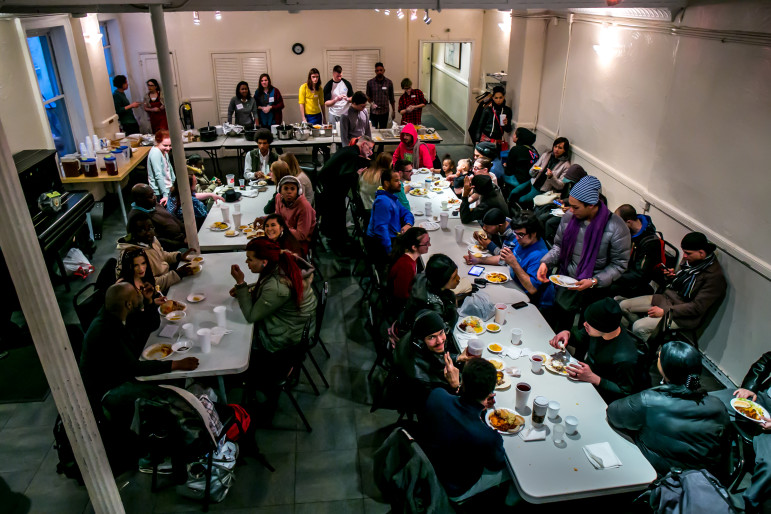It’s the first time that New York City has received the grant, despite counting roughly 7,400 homeless young people under age 24 without an adult head of household—often referred to as runaway and homeless youth (RHY)—in 2018.

Adi Talwar
Clients at New Alternatives for LGBT Homeless Youth on Christopher Street gather for Sunday in 2015.A network of young adult leaders, service providers and city officials have earned a $15 million federal grant to tackle youth homelessness in New York City through stronger coordination among municipal agencies.
The Department of Housing and Urban Development (HUD) announced the Youth Homelessness Demonstration Program award Friday as part of $145 million in grants to municipalities across the country working to end homelessness among teens and young adults. It’s the first time that New York City has received the grant, despite counting roughly 7,400 unaccompanied or parenting young people under age 25 without stable housing—often referred to as runaway and homeless youth (RHY)—in 2018. The city identified 7,008 homeless young people in 2019 and 6,753 in 2020. Advocates say those numbers are likely significant undercounts.
The city’s Continuum of Care, a coalition of people experiencing homelessness, providers, advocates and government agencies, will next develop an action plan to submit to HUD. The work will be driven by the Youth Action Board (YAB), a group of teens and young adults who have experienced homelessness.
YAB Coordinator Maddox Guerilla said the award was the result of “the tireless effort of youth with the lived experience of homelessness leading this work—on the ground.”
“Alongside our allies, we have successfully fought for this to be a truly collaborative and intentional process,” Guerilla added.
Members say they will focus on increasing access to housing, improving social services and bolstering peer guidance initiatives. Elizabeth Sutter, another YAB member, said peer navigation programs are essential for reaching young people who are not connected with support services or housing.
“Some people are more likely to take to important information when it’s coming from someone who has been in the system,” Sutter said.
As New York City contends with an historic homelessness crisis, advocates and young people have worked to expand youth-specific permanent housing programs, supportive services and transitional beds and to improve coordination among government agencies. The vast majority of homeless youth are people of color, including a large percentage of LGBTQ+ New Yorkers, and advocates say city agencies—like the Department of Youth and Community Development, the Administration for Children’s Services, Department of Homeless Services and the Department of Education—have only recently begun working together to address the crisis.
READ MORE: Amid Youth Homeless Crisis, NYC Has Ramped up Shelter Capacity
“One of the most rewarding things is to continue to strengthen our cross-systems collaboration because right now the response to youth homeless is so siloed through the city agencies,” said Coalition on Youth Homelessness Executive Director Jamie Powlovich. “This forces city agencies to sit at a table together to come up with solutions across the board, and make sure those solutions are also agreed to by the young people experiencing homelessness.”
In response to advocacy by young people and service providers, the city’s Department of Youth and Community Development added more youth shelter beds last year, bringing the total to 813. Various nonprofit providers also operate drop-in centers where young people can spend a few nights in addition to their city-funded housing programs.
Young people were also long locked out of city housing voucher programs unless they entered the adult homeless system—a potentially dangerous place, particularly for young people who identify as LGBTQ+. In July, however, the Human Resources Administration began a pilot program to provide CityFHEPS vouchers to some people staying in youth shelters or drop-in centers. Young people will also be prioritized for about 600 Emergency Housing Vouchers issued to New York City by the federal government.
The Continuum of Care members will continue working on their action plan into the next mayoral administration. A City Hall spokesperson said they hope the next mayor will coordinate with the providers and participants to further goals and strategies for ending youth homelessness.
The efforts are crucial for determining the true scale of youth homelessness and connecting with many more young people, said Amy Wilkerson, vice president of youth services at the service agency Sheltering Arms.
“Getting this funding is huge for our city,” Wilkerson said. “We have so many homeless youth here and the issue of homelessness for youth is so pervasive, people don’t know because they still go to school every day, they still go to work every day and they don’t have a stable place to live.”
“Hopefully we create a model and blueprint that can end youth homelessness, or at least create a system that does not allow an individual to remain homeless,” Wilkerson added.










One thought on “NYC Receives Long-Sought Grant to Tackle Youth Homelessness”
Congratulations to the Continuum of Care and the Youth Advisory Board for their work in earning this transformational grant award from the Department of Housing and Urban Development. I look forward to continued coverage of how their work will positively impact their lives of young people who are experiencing homelessness.